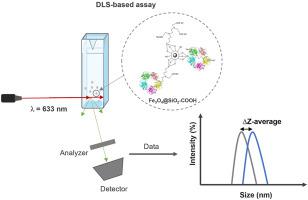Analytica Chimica Acta ( IF 6.2 ) Pub Date : 2022-07-19 , DOI: 10.1016/j.aca.2022.340169 Maria António 1 , Tânia Lima 2 , Rui Vitorino 3 , Ana L Daniel-da-Silva 1

|
In this work, we present a simple method for label-free detection of C-reactive protein (CRP) in diluted saliva samples without the use of specific molecules against CRP. We use the dynamic light scattering (DLS) technique and silica-coated Fe3O4 nanoparticles (∼50 nm in diameter) functionalized with amino carboxylate moieties (Fe3O4@SiO2/COOH) as probes. After contact with the sample, the particles could be easily separated with a handy magnet and redispersed for DLS analysis simply by vortex shaking. The variation of the hydrodynamic diameter of the nanoparticles (Z-average size) could be correlated with the concentration of CRP up to concentrations of 10 mg L−1. The detection limit (LOD) in diluted saliva samples that were spiked with CRP was 0.205 mg L−1, which is below salivary levels of CRP detected in unhealthy individuals. The coefficient of variation was found to be less than 1.5% in the entire detection range. The variation of Z-average size of non-functionalized silica coated nanoparticles (Fe3O4@SiO2) also correlated well with CRP concentration. Nevertheless, the Fe3O4@SiO2/COOH nanoparticles were less susceptible to interference from other biomolecules present in saliva and adsorbed more CRP, indicating higher selectivity toward CRP than nonfunctionalized nanoparticles. This higher affinity was attributed to the chelating interaction between the aminocarboxylate groups of the organosilane N-[3-(trimethoxysilyl)propyl]ethylenediaminetriacetic acid trisodium salt (EDTA-TMS) grafted onto the surface of the Fe3O4@SiO2/COOH nanoparticles and the Ca2+ ions of CRP. LC-MS/MS analyses allowed identification of the proteins adsorbed on the nanoparticles and confirmation of the presence of CRP, which is involved in several biological processes, including immune response, response to stress and transport.
中文翻译:

使用磁性纳米粒子检测 C 反应蛋白的无标记动态光散射测定
在这项工作中,我们提出了一种简单的方法,用于在稀释的唾液样本中无标记检测 C 反应蛋白 (CRP),而无需使用针对 CRP 的特定分子。我们使用动态光散射(DLS)技术和用氨基羧酸盐部分(Fe 3 O 4 @SiO 2 /COOH)作为探针官能化的二氧化硅涂层的 Fe 3 O 4纳米颗粒(直径约 50 nm )。与样品接触后,可以使用方便的磁铁轻松分离颗粒,并通过涡旋振荡重新分散以进行 DLS 分析。纳米粒子的流体动力学直径(Z-平均尺寸)的变化可能与高达 10 mg L -1浓度的 CRP 浓度相关. 加标 CRP 的稀释唾液样品中的检测限 (LOD) 为 0.205 mg L -1,低于在不健康个体中检测到的 CRP 唾液水平。在整个检测范围内发现变异系数小于 1.5%。非官能化二氧化硅涂层纳米粒子(Fe 3 O 4 @SiO 2)的 Z 平均尺寸的变化也与 CRP 浓度密切相关。尽管如此,Fe 3 O 4 @SiO 2/COOH 纳米颗粒不易受到唾液中其他生物分子的干扰,吸附更多的 CRP,表明对 CRP 的选择性高于非功能化纳米颗粒。这种更高的亲和力归因于接枝到 Fe 3 O 4 @SiO 2 /COOH表面的有机硅烷 N-[3-(三甲氧基甲硅烷基)丙基]乙二胺三乙酸三钠盐 (EDTA-TMS) 的氨基羧酸酯基团之间的螯合相互作用纳米粒子和 CRP 的 Ca 2+离子。LC-MS/MS 分析允许识别吸附在纳米颗粒上的蛋白质并确认 CRP 的存在,CRP 涉及多种生物过程,包括免疫反应、对压力的反应和运输。



























 京公网安备 11010802027423号
京公网安备 11010802027423号